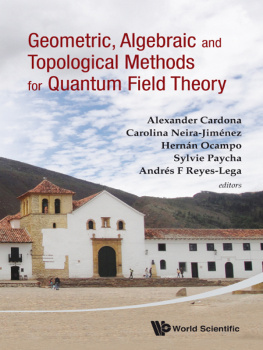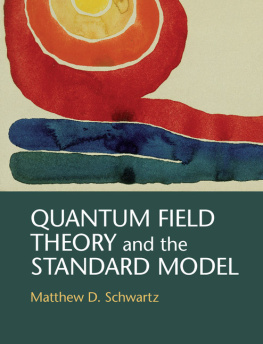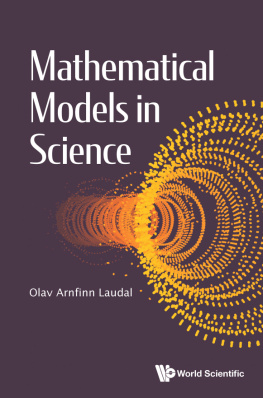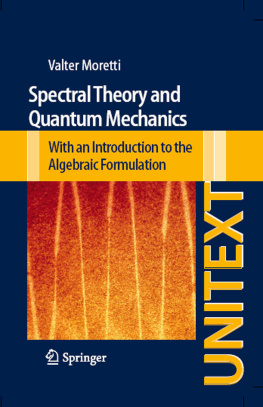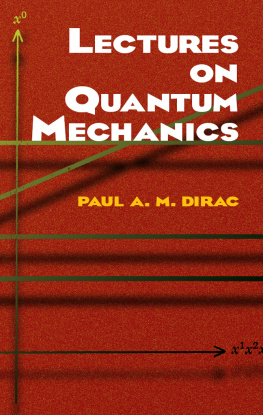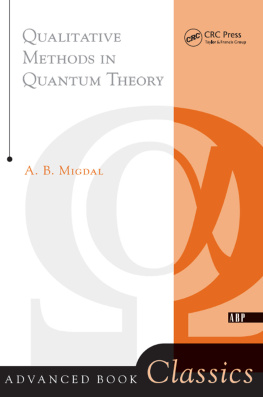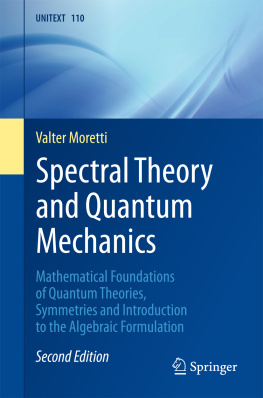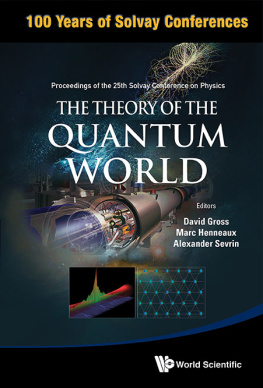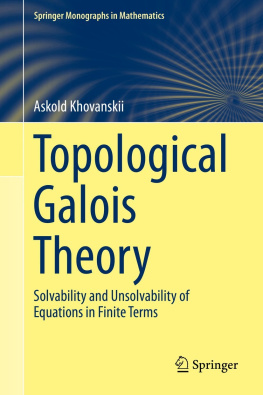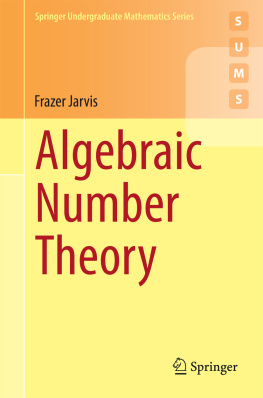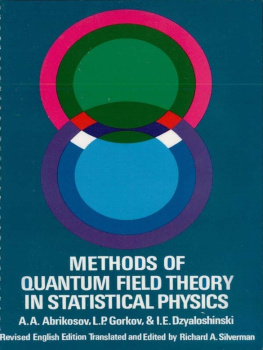
Proceedings of the 2011 Villa de Leyva Summer School
Geometric, Algebraic and
Topological Methods
for Quantum Field Theory
Proceedings of the 2011 Villa de Leyva Summer School
Geometric, Algebraic and
Topological Methods
for Quantum Field Theory
| Villa de Leyva, Colombia | 4 22 July 2011 |
Editors
Alexander Cardona
Universidad de los Andes, Colombia
Carolina Neira-Jimnez
Universitt Regensburg, Germany
Hernn Ocampo
Universidad del Valle, Colombia
Sylvie Paycha
Universitt Potsdam, Germany
Andrs F Reyes-Lega
Universidad de los Andes, Colombia

NEW JERSEY LONDON SINGAPORE BEIJING SHANGHAI HONG KONG TAIPEI CHENNAI
Published by
World Scientific Publishing Co. Pte. Ltd.
5 Toh Tuck Link, Singapore 596224
USA office: 27 Warren Street, Suite 401-402, Hackensack, NJ 07601
UK office: 57 Shelton Street, Covent Garden, London WC2H 9HE
Library of Congress Cataloging-in-Publication Data
Villa de Leyva Summer School (7th : 2011 : Leiva, Boyac, Colombia)
Geometric, algebraic and topological methods for quantum field theory : proceedings of the 2011
Villa de Leyva Summer School, Villa de Leyva, Colombia, 422 July 2011 / edited by Alexander
Cardona (Universidad de los Andes, Colombia), Carolina Neira-Jimnez (Universitt Regensburg,
Germany), Hernn Ocampo (Universidad del Valle, Colombia), Sylvie Paycha (Universitt Potsdam,
Germany) & Andrs F Reyes-Lega (Universidad de los Andes, Colombia).
pages cm
Includes bibliographical references and index.
ISBN 978-981-4460-04-0 (hardcover : alk. paper)
1. Geometric quantization--Congresses. 2. Quantum field theory--Mathematics--Congresses.
3. Topology--Congresses. I. Cardona, Alexander, editor of compilation. II. Title.
QC174.17.G46G455 2011
530.14'30151--dc23
2013037184
British Library Cataloguing-in-Publication Data
A catalogue record for this book is available from the British Library.
Copyright 2014 by World Scientific Publishing Co. Pte. Ltd.
All rights reserved. This book, or parts thereof, may not be reproduced in any form or by any means, electronic or mechanical, including photocopying, recording or any information storage and retrieval system now known or to be invented, without written permission from the publisher.
For photocopying of material in this volume, please pay a copying fee through the Copyright Clearance Center, Inc., 222 Rosewood Drive, Danvers, MA 01923, USA. In this case permission to photocopy is not required from the publisher.
Printed in Singapore
INTRODUCTION
This volume offers an introduction to some recent developments in several active topics at the interface between geometry, topology, analysis and quantum field theory:
- Spectral geometry and index theory,
- Noncommutative models and the standard model,
- Algebraic geometry and Feynman periods,
- Generalized geometries and string theory,
- Differential geometry and gravity,
- Conformal field theory and integrability.
It is based on lectures and short communications delivered during a summer school on Geometric, Algebraic and Topological Methods for Quantum Field Theory held in Villa de Leyva, Colombia, in July 2011. This school was the seventh of a series of summer schools which have taken place every other year since July 1999. The invited lectures, aimed at graduate students in physics or mathematics, start with introductory material before presenting more advanced results. Each lecture is self-contained and can be read independently of the rest.
The volume begins with the lectures on Spectral Geometry by Bruno Iochum in which, strongly motivated by physics, the author presents the fundamental concepts and results in the spectral approach to noncommutative geometry. After the analytic preliminaries necessary to define the spectral action for noncommutative spectral triples, computations are carried out in some particular cases of interest in mathematical physics, such as for Riemannian manifolds (Einstein-Hilbert action) and for the noncommutative torus.
The Atiyah-Singer index theorem and some of its generalizations are the subject of the contribution by Maxim Braverman and Leonardo Cano, based on the lectures given by the first author during the summer school. The lectures start with a review of the mathematical tools required to understand the significance of the classical Atiyah-Singer index theorem, then provides a presentation of its equivariant counterpart and goes on to a discussion of the recent developments aimed at generalizations of the index theorem for transversally elliptic operators acting on non-compact manifolds.
The third lecture, by Paolo Aluffi, is motivated by an algebro-geometric interpretation of Feynman amplitudes in terms of periods. It starts with an informal presentation of background in algebraic geometry on the Grothendieck group of varieties and on characteristic classes, both viewed as generalizations of the ordinary topological Euler characteristic. The last part of the lecture reviews some recent work on Grothendieck classes and Chern classes of graph hypersurfaces.
The fourth lecture byJorge Zanelli is an elementary introduction to Chern-Simons forms aimed at understanding their role in physics and the reason for their usefulness in gravity. The emphasis in this presentation is on the construction of the action principles and on the geometric features that make Chern-Simons forms particularly well suited for the physics of geometric systems. The gauge invariance is reviewed, putting in the forefront the local Lorentz symmetry of space-time; the abundance of local Lorentz-invariant gravitational theories is reduced by choosing the arbitrary coefficients in the Lagrangian in such a way that, in odd dimensions, the gauge symmetry becomes enlarged.
In the fifth lecture, Matilde Marcolli covers recent applications to particle physics of models inspired by noncommutative geometry. Complementing the formal mathematical aspects of the spectral action covered by Bruno Iochums lectures, the author discusses how an action functional for gravity coupled with matter on an ordinary space-time can be seen as pure gravity on a noncommutative product geometry. Also, it is shown how the type of noncommutative geometry involved determines the physical content of the theory, i.e. the type of fermionic and bosonic fields present in the theory. The lecture ends with an analysis of physical consequences of such particle models which include the Higgs mass prediction.
The sixth lecture by A.P. Balachandran begins with a review of the motivation for noncommutative spacetimes which arises from quantum gravity. After a physically motivated introduction to Hopf algebras, the construction of covariant quantum fields on such spacetimes is discussed. This formalism is then applied to cosmic mircowave background and to the prediction of apparent non-Pauli transitions. The lecture ends with a discussion of limits on the scale of noncommutativity, derived from experimental data.
Integrability, a way to test the so-called Maldacena conjecture, is the theme of Matthias Staudachers Lecture. It first gives a presentation of the Yang Baxter equations presented as an algebraic integrability condition by means of the one dimensional spin chain and the Bethe Ansatz. The author then discusses the
Next page
